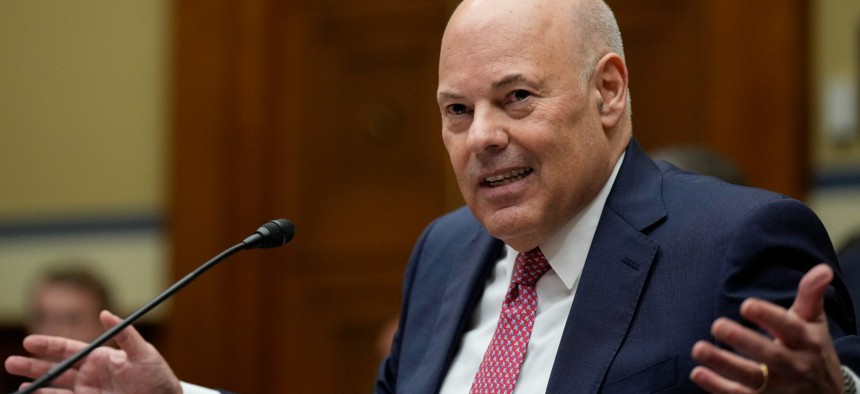
Postmaster General Louis DeJoy said actions to improve the mailing agency's finances will include significantly reducing work hours by closing some facilities and removing other inefficiencies. Drew Angerer / Getty Images
DeJoy pledges to trim workforce costs as USPS continues to lose more money than expected
The Postal Service has found some success in eliminating costs from its network, but overall expenditures spiked in the most recent quarter.
The U.S. Postal Service lost $1.7 billion from April through June of this year, with revenue dropping by 1% compared to the same period in 2022 and operating costs spiking by 10%.
Postmaster General Louis DeJoy once again recognized the mailing agency’s finances are not in the place he had hoped for by this point in his tenure, but vowed to double down on and accelerate his proposed reforms to right the ship. Among the solutions, he said, would be significantly reducing work hours by closing some facilities and removing other inefficiencies.
Already, USPS has begun closing annexes and contract facilities around the country that management has labeled as “inefficient.” Improved processes, DeJoy said, have led to 30 million fewer work hours so far this year compared to 2022, realized primarily by reducing overtime.
The Postal Service’s losses marked a dramatic downturn from the third quarter of fiscal 2022, when the agency—primarily due to one-time benefits of the passage of the Postal Service Reform Act—turned a profit of nearly $60 billion. First-Class mail volume declined by 6% this quarter compared to the prior year, though its revenue increased by 4% due to significant increases in mail prices. Marketing mail volume dropped by 16%.
DeJoy cited a market-wide cutback in advertising spending, significant inflation costs and a required overpayment into the agency's pension fund as the primary drivers of cost overruns, noting those factors added $6 billion to its expenditures.
In DeJoy’s 10-year business plan, he had originally projected that fiscal 2023 would mark the first year in nearly two decades that USPS would break even. He conceded in November that goal was no longer possible and predicted his agency would instead lose $4 billion on the year. To date, the agency has lost $5.2 billion this fiscal year. DeJoy said postal management is “working diligently” to address the unforeseen setbacks to “bring our financial trajectory closer to our original goals.” He hinted at further cost cutting and, one again, asked for the postal community not to stand in his way.
“This will require the projected lower inflation rates to be experienced, continued but more aggressive cost reductions to our operations, increased market-dominant and package revenue, exceptional management execution, the usual great support from our employees and cooperation from our stakeholders,” DeJoy said.
Despite the setbacks, the agency—primarily through the passage of the 2022 Postal Service Reform Act—has eliminated $90 billion from its $160 billion in projected 10-year losses.
In addition to the projected cuts, DeJoy said USPS will make investments and grow revenue. That will include a “variety of initiatives” aimed at cashing in on its interconnected retail network and by capturing a larger market share in packages through its new, streamlined shipping service.
The Postal Service is planning to spend $20 billion in deferred maintenance and 85% of the overall investments next year will go toward existing facilities. The first of its new fleet of electric vehicles will hit streets this year, with 9,000 deployed next year. USPS has begun opening its first mega-centers—known as Regional Processing and Distribution Centers—and will open nine more in the next year-and-a-half. It will open more than two-dozen sorting and delivery centers, which shift daily mail sorting away from local post offices in favor of more centralized locations, in that period. The plan has faced bipartisan opposition in Congress.
While cutting work hours and consolidating facilities, DeJoy boasted of improvements to the workforce. More staff are in career-designated roles, supervisor vacancies are declining, overtime is down and employee availability has improved throughout most of the country. As a result, DeJoy said, seasonal hiring for the holidays is expected to be “very limited in scope” compared to years past. Last year, USPS initially planned to hire 28,000 temporary workers for the peak season, down from 45,000 it brought on the year before. It subsequently decreased the target to 20,000.
The postmaster general said he will continue to grow revenue through continuing his strategy of increasing mail rates. The agency has saved $1 billion by reducing its reliance on air transportation by 90% over the last two years, DeJoy said, and USPS now ships 95% of its mail and packages on the ground.







